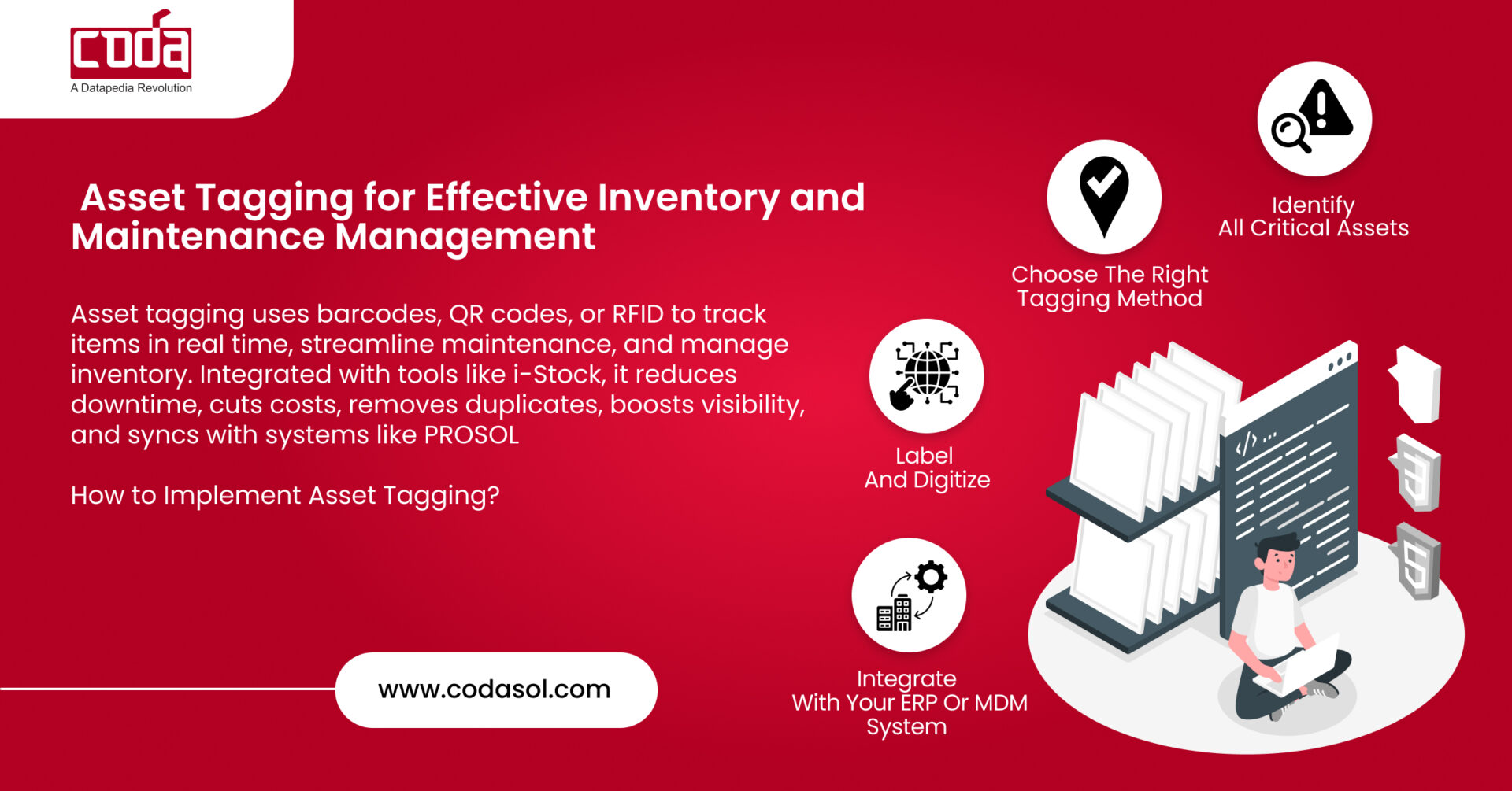Tired of hunting for missing assets? Or worse, duplicating purchases you already made? You’re not alone. Industries from Oil & Gas to Healthcare are losing millions due to poor asset tracking.
Here’s the good news: Asset tagging when done right can solve this.
Let’s dive into how asset tagging, especially when powered by tools like i-Stock, can transform inventory and maintenance management into a streamlined, data-driven powerhouse.
If you’re struggling with inaccurate inventory data, duplicated materials, or labor-intensive audits, you’re not alone. But you’re also not stuck. Solutions like i-Stock, a mobile-based inventory verification tool, are changing the game.
What Is Asset Tagging?
Asset tagging involves assigning a unique identifier usually via barcodes, QR codes, or RFID to every physical item within an organization. These tags enable real-time tracking, easier maintenance scheduling, and streamlined inventory management.
When integrated with digital tools like i-Stock, asset tagging evolves into a powerful strategy for:
- Reducing downtime
- Cutting procurement costs
- Eliminating duplicates
- Enhancing visibility across warehouses
- Syncing with ERP and MDM systems like PROSOL
Why Asset Tagging Matters in Inventory and Maintenance
For companies operating in GCC countries like the UAE and Saudi Arabia, or in Far East regions like Japan and South Korea, compliance, traceability, and uptime are non-negotiable. Add in the vast asset volume and complex maintenance needs, and manual tracking becomes a liability.
Top Problems Solved by Asset Tagging:
| Challenge | Solution via Asset Tagging & i-Stock |
|---|---|
| Missing part numbers | Tagging ensures traceability and identification |
| Duplicate inventory | Barcode-based scanning prevents duplication |
| Unverified or outdated stock | Real-time physical verification updates records |
| Inaccurate maintenance records | Each tag logs condition and lifecycle data |
| Delayed audits and stock checks | Mobile audits from i-Stock save hours per cycle |
Introducing i-Stock (Redefining Inventory Audits)
Digitize your inventory audits. Reduce effort. Gain real-time stock visibility.
i-Stock is an Android-based, cloud-enabled inventory audit tool integrated with the PROSOL platform. Built for warehouse environments, i-Stock enables rapid, paperless, and accurate MRO inventory verification—all from your mobile device.
Key Benefits:
- Real-Time Tagging: Instantly tag and update asset data with barcode or QR scanning.
- Mobility: Conduct audits from any Android device—no paper, no delays.
- Cloud Integration: Sync data across warehouses, business units, and ERP systems.
- Accuracy: Verify, cleanse, and tag materials with speed and precision.
- Seamless MDM Workflow: Data flows directly into PROSOL, enabling smarter decisions and better compliance.
Case Study
Industry: Supply Chain & Asset Pooling
Region: India
Assets: 6 million+ across 2,500+ locations
Their Problem:
- Unverified, duplicate, and untagged assets
- Lack of standardization for materials
- Difficulty verifying aged or damaged items stored in hard-to-reach areas
Our Solution with i-Stock:
- Mobile-based physical inventory verification
- Image capture and data tagging of each material
- Cleansing and deduplication of material master data
- Seamless SAP integration via PROSOL
Outcome:
- Improved inventory accuracy
- Reduced procurement costs
- Enhanced asset visibility
- Optimized resource allocation
This transformation delivered tangible ROI and operational efficiency.
Ready to cut inventory errors by 90%?
Get a free demo of i-Stock and see real-time visibility in action.

How to Implement Asset Tagging in 5 Simple Steps
- Identify all critical assets – Start with MRO, tools, and high-value equipment
- Choose the right tagging method – Barcode for affordability, RFID for bulk or remote tracking
- Label and digitize – Use tools like i-Stock to scan and update your inventory database
- Integrate with your ERP or MDM system – Ensure real-time data flow (e.g., into PROSOL)
- Train your team – Make mobile-based audits the new norm
How Asset Tagging Supports Maintenance Management
Beyond inventory tracking, asset tagging plays a crucial role in preventive maintenance and lifecycle management.
Here’s how:
- Scheduled Maintenance Alerts: Each tagged asset includes maintenance schedules and logs.
- Condition Monitoring: Data from field checks syncs instantly, flagging issues early.
- Part Replacement History: Maintenance records tied to unique asset IDs streamline repairs.
- Lifecycle Visibility: Know when to repair, replace, or dispose.
Industries like Marine & Ports, Aviation, Healthcare, and Defence especially benefit from this proactive approach.
i-Stock vs Traditional Methods
| Feature | Traditional Inventory Methods | i-Stock Digital Solution |
|---|---|---|
| Data Entry | Manual & prone to errors | Automated, barcode & cloud-enabled |
| Time per Audit | Days or weeks | Hours or less |
| Duplicate Check | Manual, post-process | Real-time, during scan |
| ERP Sync | Delayed or semi-manual | Instant sync with PROSOL/SAP |
| Maintenance Logging | Fragmented or missing | Integrated with asset tag |
| Audit History | Scattered across documents | Centrally stored, searchable |
Who Needs Asset Tagging the Most?
Industries Benefiting from i-Stock and Asset Tagging:
- Oil & Gas: Ensure critical parts and tools are always ready.
- Utilities: Maintain uptime with fast asset checks.
- Real Estate & Construction: Track high-value materials across sites.
- Manufacturing: Avoid shutdowns with accurate maintenance tagging.
- Healthcare: Ensure compliance and quick access to life-saving equipment.
- Banking & Government: Monitor and control fixed asset inventories.
- Marine, Ports & Aviation: Track location and condition of mobile assets.
- Defense & EPC: Securely manage a wide array of technical equipment.
Frequently Asked Questions
1. What types of assets should be tagged?
All high-value, frequently moved, or maintenance-intensive assets should be tagged, ranging from tools and machinery to electronics and spare parts.
2. How does i-Stock help reduce duplicates?
i-Stock’s barcode scanning instantly checks existing records, alerting users of similar or duplicate entries during audits.
3. Can i-Stock integrate with SAP or Oracle?
Yes, i-Stock is designed to sync seamlessly with major ERPs like SAP, Oracle, and Maximo, through the PROSOL platform.
4. Is it suitable for field operations or only warehouses?
i-Stock is mobile-first and works in both warehouse and field conditions, including remote or offshore facilities.
5. What’s the ROI on asset tagging and i-Stock implementation?
Typical clients see payback within 6 months, with savings from duplicate elimination, improved audits, and reduced procurement costs.
Final Thoughts
Asset tagging is not just about knowing what you own, it’s about unlocking the full value of your inventory.
With digital tools like i-Stock, businesses in India, the GCC, the Far East, and the US are stepping into a new era of inventory accuracy, operational efficiency, and data-driven maintenance.
Whether you’re managing a power plant in Abu Dhabi, a hospital in Singapore, or a warehouse in Houston, asset tagging with i-Stock can be your invisible superpower.

Tired of duplicate materials inflating your procurement spend?
Explore how i-Stock + PROSOL help you take control of your MRO data.

